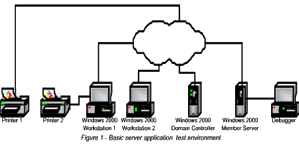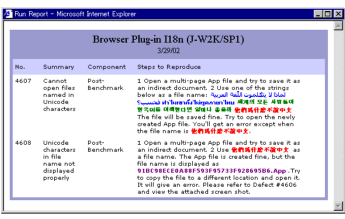Application quality control and stability has increasingly taken center stage, as businesses focus on securing their enterprises in today's global and connected environments. Failure of one application can effect the entire enterprise. Skandis Systems offers effective quality assurance and testplan services to help clients circumvent application failures and security breaks with cost-effective solutions.
|

 Core Technologies Core Technologies |
Some test applications can be adequately tested using a standalone computer system. For other applications, a more complex network environment will be required. Skandis Systems maintains advanced development labs with multi-language operating systems and third-party test tools networked within a secure VPN.
|

|
 Generate Testplan.
Application-specific testplans should test for functionality, stability, consistency and, to be certified under a specific platform, for compliance. Skandis Systems experience in both Windows and Unix platforms is leveraged to efficiently and cost-effectively develop compliance testplans specific to a client's application requirements.
Generate Testplan.
Application-specific testplans should test for functionality, stability, consistency and, to be certified under a specific platform, for compliance. Skandis Systems experience in both Windows and Unix platforms is leveraged to efficiently and cost-effectively develop compliance testplans specific to a client's application requirements. |

Multi-lingual Sufficiency Testing

Generate and Execute Testplan to Verify Multi-lingual Functionality |
|
Globalization is the practice of designing and implementing software that is locale independent so that it can accommodate any locale. A locale is defined as a set of user preferences associated with a user's language. For example, a locale in Windows 2000 includes formats for date, time, currency and numbers; rules and tables for sorting and comparison; and tables of character classifications. Testplans should include tests for locale language dependency, as well as sorting, comparison and character classification language dependencies.
Other user preferences that a multi-lingual testplan should check include user-interface language, default font selection, language rules for use in spell checking and grammar, and input methods such as keyboard layouts and input method editors, as well as checks described below under Localization and Linguistic Verification Testing.
The screenshot to the right illustrates the results of executing a testplan to specifically test for multi-lingual functionality. In this example, the testplan has detected bugs while processing multi-lingual file names within a Windows 2000 environment. The application will not accept a Unicode-encoded file name containing non-ANSI characters.
|

|

Localization and Linguistic Verification Testing

|
|
Localization and linguistic verification testing is the practice of verifying all localized components within an application are correct and consistent throughout the application for each targeted locale. Multi-lingual testplans should include checks for user-interface language consistency, correctness and usage, as well as checks described above under Multi-lingual Sufficiency Testing.
The following code snippet shows two, user-interface testplans, the original English testplan, and the corresponding localized testplan for Japanese. This example code illustrates the effectiveness of multi-lingual testplans in the localization and linguistic verification process. Employing multi-lingual testplans automates the testing process and further ensures results are verifiable and repeatable.
|
| Testplan for English UI |
Testplan for Japanese UI |
[-] window DialogBox RB
[ ] msw parent TestApp
[-] RadioList TheRadioList
[ ] tag "The radio buttons"
[-] RadioButton TheFirstChoice
[ ] tag "The first choice"
[-] RadioButton TheSecChoice
[ ] tag "The second choice"
[-] StaticText LabelText
[ ] tag "Label"
[-] TextField Label
[ ] tag "Label"
[-] PushButton Exit
[ ] tag "Exit(E)"
[-] CheckBox Enabled
[ ] tag "Enabled"
[ ]
|
[-] window DialogBox RB
[ ] msw parent TestApp
[-] RadioList TheRadioList
[ ] tag "ラジオボタン"
[-] RadioButton TheFirstChoice
[ ] tag "最初の選択"
[-] RadioButton TheSecChoice
[ ] tag "2番目の選択"
[-] StaticText LabelText
[ ] tag "ラベル"
[-] TextField Label
[ ] tag " ラベル"
[-] PushButton Exit
[ ] tag "終了(E)"
[-] CheckBox Enabled
[ ] tag "有効"
[ ]
|
|

Load Balancing and Stress Testing

|
|
Today more than ever, mission critical and networked applications must be tested for high-level of availability and stability as access to networked applications across LAN, WAN, Intranet and Internet increases the potential for service denials. Stress testing and load balancing help prevent unintended DOS and ensure applications provide acceptable response time. Skandis Systems maintains advanced QA labs capable of performing load balancing and stress testing for the most complicated and resource-intensive applications.
|

Efficient and Cost-Effective

|
|
Skandis Systems maintains advanced development labs with multi-language operating systems and third-party test tools networked within a secure VPN. Our QA engineers are multi-lingual and experienced in cross-industry applications. This makes outsourcing QA and testing to Skandis Systems both efficient and cost-effective for clients with both global and domestic requirements.
|
| |